Gotcha!
I’ll admit, that title was a bit of a ruse; however, by the time this article is done, hopefully you’ll have a newfound appreciation for a card that’s gotten an unfair shake as “a bad Augur of Bolas” as well as a new deck to rock that fuses the powerful elements of two different winning Standard decks.
Let’s get the deck out of the way first, since that gives me the vehicle to explain my newfound love for the one who voices omens.
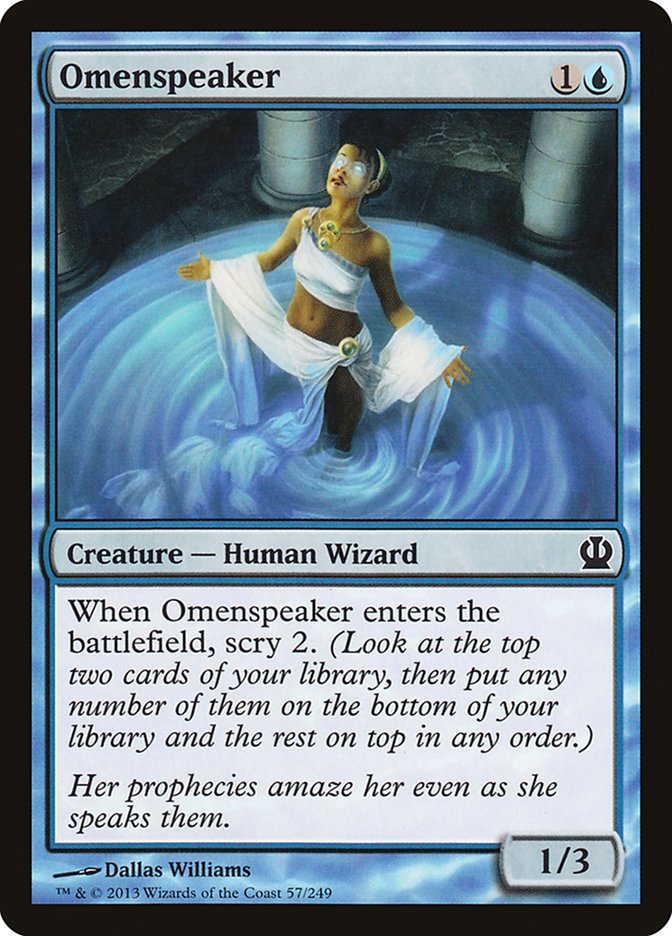
It all started with my article talking about working within the confines of Standard. I talked about Master of Waves and how I thought it could make it before soliciting some great suggestions from you all; some nice lists were posted showing that we were on track with the greatest minds in the game. I was hooked on the card from that point.
Two weekends ago, our fellow writer Brian Braun-Duin earned a well-deserved trophy at Grand Prix Louisville piloting a list powerful enough to place not only BBD but also two of his teammates into the Top Eight: Mono Black Devotion. Watching coverage, I was consistently impressed by the power that the deck possessed. Brad Nelson would just decimate his Esper Control opponents, time after time, regardless of how many Supreme Verdicts or Detention Spheres were played. BBD even took the deck to the Invitational and was in the Top Eight with Gerry Thompson, who was also running the deck.
Every one of Mono Black’s creatures seemed to require a Supreme Verdict to answer it on a one-for-one level. The pilot never had to deploy more than one threat at a time to truly pressure their opponent. They could just play a Desecration Demon and sit back on their Underworld Connections until they could pull a surprise kill out of nowhere using Gray Merchant of Asphodel.
Color me impressed.
So two weeks, two professional events, two devotion decks taking down the trophy. Yes, these decks were laser focused on taking advantage of the devotion mechanic, but is that really the only direction we can go?
I’d like to think the answer to that question is no. I think that we have just begun to scratch the surface on what’s possible yet.
Quick question: what card/cards were present in both winning lists of Pro Tour Theros and Grand Prix Louisville?
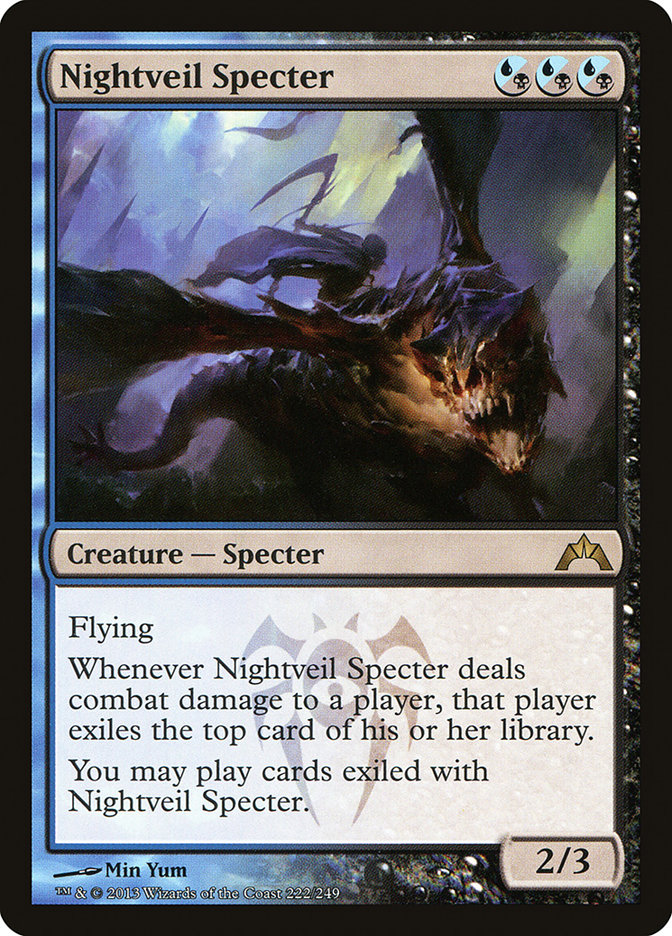

Nightveil Specter was the card in both that has really broken out. Like Boros Reckoner, if you’ve devoted yourself completely to playing the correct color(s), you get a really powerful three-drop that adds a ton of devotion. People slept on Nightveil Specter last season because we lived in a world of Restoration Angel, Angel of Serenity, and Thundermaw Hellkite. Why would you want to be casting a 2/3 for three?! (Well, other than Vampire Nighthawk, which could actually tangle with those creatures profitably.)
Now, the inherent power level of the format has decreased; by that I mean that the cards we have available aren’t as independently powerful as they were in the previous Standard format and we can’t simply jam all of the powerful cards into one deck and call it a day. Due to this fact, the decks we have in Standard right now (while contextually powerful in the current format) aren’t as powerful or oppressive as what we faced before.
I bring all of this up to piggyback a bit off of what BBD said in his article last week:
“… I’ve been growing more and more fed up with the prevailing attitude I see in a lot of Magic players where they will instantly bash a deck or a card choice without really giving any consideration to how it could be good. When you write an article and do a video each week, you get to see a lot of people critiquing your every move, and I was seeing a lot of people sharing this dismissive attitude when it comes to Magic cards. It annoyed me when people attacked me for playing those cards. I thought they were wrong, and I thought they were being shortsighted by instantly rejecting two playable cards solely because they were bulk in the previous format.
Formats change. Cards change in playability.”
The card does more than just enable devotion; if left unchecked, it will simply take over a game with the card advantage it provides. It also serves the “take your hoagie from you and beat you about the head with it” role as well. The fact that it has three colored mana symbols in the mana cost just adds delicious icing to that… um… hoagie.
The other cards in the two decks either further contribute to their respective devotion count or take advantage of the devotion count: the payoff, as it were. Here are the rewards for being devoted in those two lists:
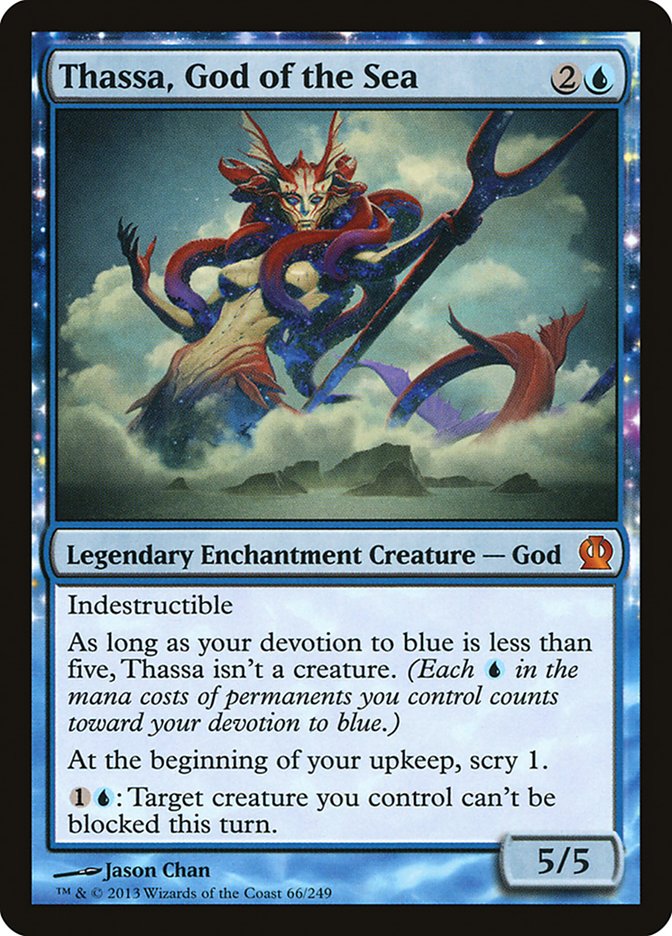
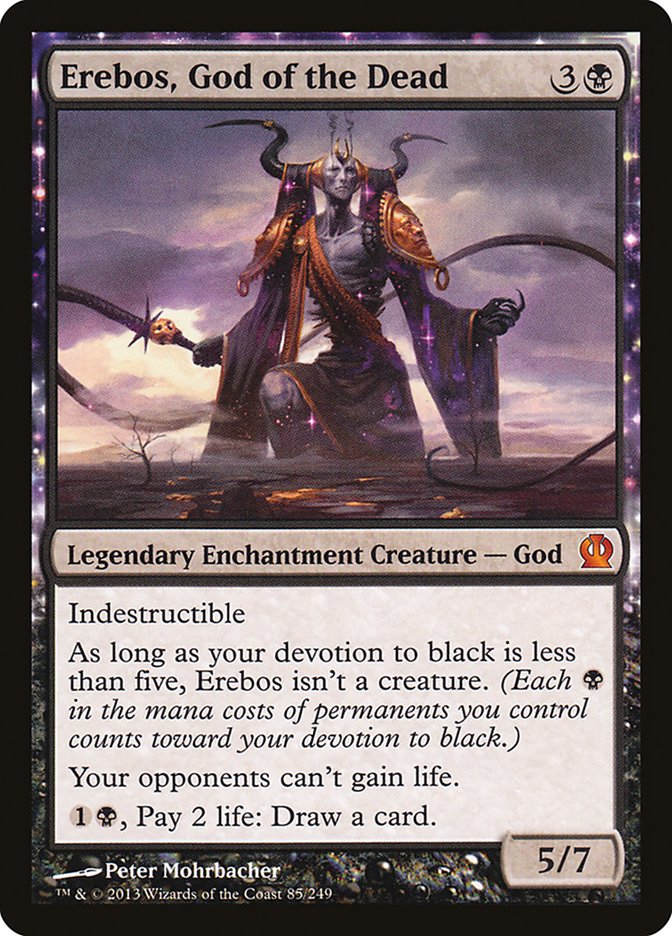
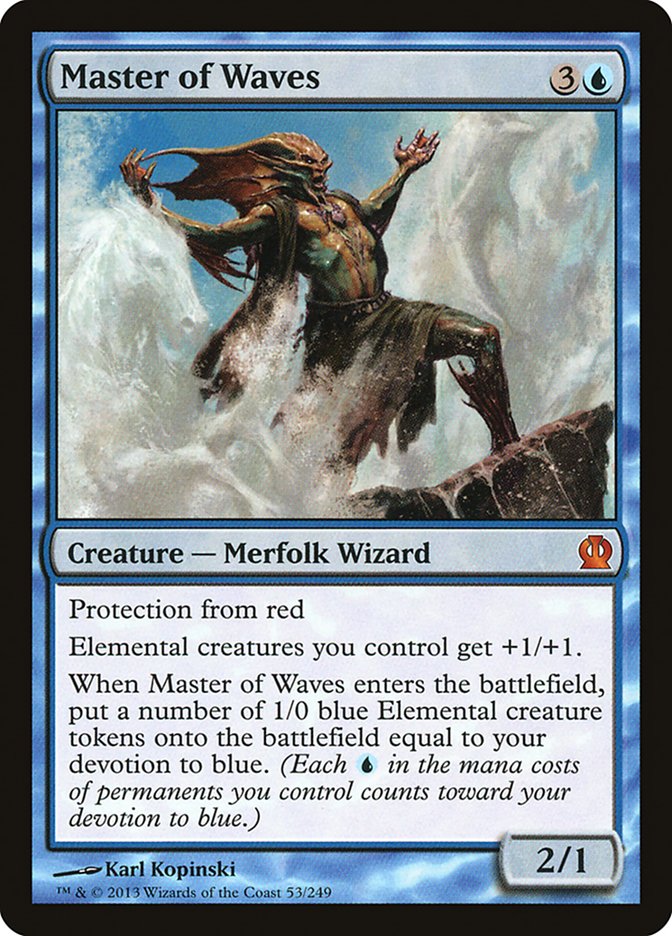
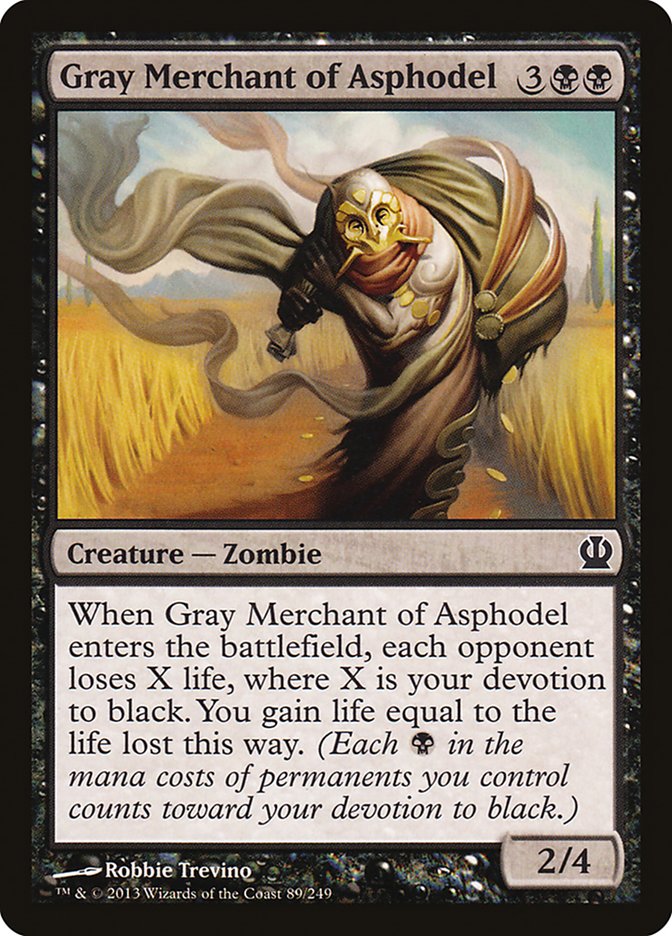
We can break that list up into two distinct lists: gods and non-gods. Or, “cards that you pretty much have to be monocolored to play” and “cards that get better the closer to monocolor you are”. With the two Gods, I wouldn’t run them unless I was planning on actually bringing them down to earth as creatures. While scrying every turn and making some creatures unblockable is nice, not being able to make Thassa herself unblockable (and take out five point chunks of life from your opponent) means I won’t be running her.
However, with Master of Waves and Gray Merchant, even by themselves they’re not dead cards. While I’m not overjoyed about getting a 2/4 who drains for two life, you can still win with it if push comes to shove (ie, it can still attack for two and is a warm body). While not having any other blue mana symbols isn’t great when you play a Master of Waves, you still get four power for four mana, two of which has protection from red and pumps any of your Mutavaults.
Obviously, you’ll try to do better than that with both of those creatures, but my point is that you can run them without fully devoting yourself to making them ridiculous.
So this got the juices flowing: could I combine these two decks? Some of the best decks that have dominated (or at least done really well in) their formats have been fusions of two different deck ideas. Thopter Depths, TwinBlade, Kiki Pod, and U/W/R Delver Blade are just some relatively contemporary examples of this concept. Is this another time for a fused deck?
Let’s give it a shot:
Creatures (17)
Planeswalkers (3)
Lands (25)
Spells (15)

This is very close to the list I would have run this past weekend if life and circumstance didn’t prevent me from traveling to Indianapolis for the Invitational.
The list initially started out much closer to the black lists in that they were running Pack Rat and the fourth Underworld Connections. I quickly realized that most of the time I just wanted a Jace, Architect of Thought and started to shift the deck more and more to the blue side of things.
I’d like to think that right now I’m somewhere in the middle, which creates some very weird draws while also drastically altering the power level of some of the cards in the deck based on the draw you have. When you’ve curved from Omenspeaker into Jace, Architect of Thought, that Gray Merchant of Asphodel isn’t really what you want to be doing. Ditto to draws where you have Underworld Connections, Desecration Demon, and Master of Waves.
This is where Omenspeaker rears its ugly (beautiful?) head.
You see, when I first started trying to create this deck, I had zero Omenspeakers. I remember my first exposure to the card, the initial “oh, this is like a bad Augur of Bolas” reaction, then the dismissal of the card.
This was just wrong
Omenspeaker is closer to Preordain than it is to Augur of Bolas, at least in the context of this deck.
Think about it this way: you are playing a card to scry two and end up with a card left over. With Preordain, you only had to pay one mana and you got to immediately draw the card. With Omenspeaker, you have to pay two mana and the “card” you gain is simply that unexciting 1/3 body you get up front. Obviously Preordain is better because late game, the card you end up with is likely going to be better than a 1/3. I get it.
But this is Standard, and I can’t play the actual card Preordain damnit.
The thing that people miss when comparing this to Augur of Bolas is that the two cards are attempting to do vastly different things. Augur wants to hopefully draw you a card when it comes into play. You’re trying to get ahead on card advantage with Augur. However, just because Omenspeaker isn’t trying to gain card advantage doesn’t mean it’s not on par with Augur. Instead of trying to get you ahead on card quantity, Omenspeaker is getting you ahead on card quality.
Or, think about it this way: Brainstorm doesn’t actually gain any card advantage. It simply improves your card quality. I’m not saying Omenspeaker is Brainstorm by any means, but it sure isn’t Maritime Guard.
Another thing people bring up is how no one played Augury Owl, and it scry’d for three! Here’s the thing; no one wants a 1/1 body. Even with flying. It just doesn’t do anything. Again, think about it this way: you played Augur of Bolas, even in Bant Control, but when did you ever play with Elvish Visionary? It even guaranteed you a card. The body just wasn’t relevant enough to get you to play with it.
However, when you play a 1/3 on turn two, you’ve put the brakes on your aggressive opponent. Their Soldier of the Pantheon or Dryad Militant is just dead in the water. Even their Rakdos Cackler just looks silly (something that isn’t the case when you play an Augury Owl). Omenspeaker (and Augur of Bolas) both have the unwritten, hidden ability attached to them of “shut down target aggro player’s attack phase for a turn or two”.
Oh, and if you have an active Underworld Connections, you get to actually build your own Preordain with Omenspeaker, so there’s that.
Back to the deck: I initially included just two Omenspeakers, hesitant to play more of the “bad Augurs” until I got some games in and realized just how awesome it was in the deck. Again, the deck is essentially two powerful strategies stitched together with two sugar packets, a twig, and Nightveil Specters; while the deck ended up being smoothed out to something I actually wanted to put my tournament life on the line for in Indianapolis, I promise I would have long ago given up on the deck if not for Omenspeaker. Between Temple of Deceit and Omenspeaker, I feel like I have full control over which gameplan I’m going to pursue and my deck can take on whichever role it needs to.
This is why I’m saying Omenspeaker is similar to Preordain; back when Preordain was in Standard, I ran it in pretty much every deck I played. Now, granted, this is probably because I spent the vast majority of my time playing R/U/G Titan with Jace, the Mind Sculptor and Lotus Cobra, but even when I branched out and played U/B Control or Twinblade, I still played Preordain. I loved having control over my draws because my single biggest pet peeve when it comes to Magic is losing before the game even starts due to my draw.
I love being in control
I’ve even started remembering a lot of the “Preordain” rules, like “save Preordain until later in the game, even if you can cast it on turn one, if you’ve already got a two drop and action behind it”. I do this now with Omenspeaker; if I have action and lands and don’t need anything in particular, I’ll save Omenspeaker. The difference here is that the last bit of benefit to running Omenspeaker is the ability to add to your devotion, meaning there will be games where you have to run it out on turn two in order to curve from it to Specter to Master of Waves. If you’re doing that, though, I don’t think you’ll be needing any late-game scrying power.
The other question we must ask ourselves is this: is this really better than just running one or the other? Follow up questions would be: “is it worth losing the respective god?”, “what do you gain by adding the two together?”, and “is it worth the drop in consistency of mana?” There are decks that both Blue and Black Devotion decks have issues with. Blue struggles with Esper Control while Black beats it to hell and back. Black struggles when decks get out in front of it, like red-based aggro; Blue has Master of Waves and Omenspeaker to help put the kibosh on their aggressive plans.
So for now, I’m working on this deck to try to pull the best aspects of each in order to circumvent the weakness of the other. The only way this works is having the scrying ability of Temple and Omenspeaker in addition to the double devotion duty that Nightveil Specter brings.
Speaking of Nightveil Specter: we’re talking about how scrying allows you to sculpt a specific game plan based on which color you want to be devoted to, but if you have a Specter, you can pretty much keep everything since Specter makes all of your cards awesome.
Think of this curve:
T1: Thoughtseize
T2: Omenspeaker
T3: Nightveil Specter
T4: Master of Waves
T5: Gray Merchant of Asphodel
Even if your opponent has some blockers, that’s pretty much going to be lethal, or close enough to it for the subsequent attacks from the remaining Elemental tokens.
So now we know what the positives are, what are the negatives? Well for one, we don’t get to play the Gods. This is actually a bigger deal with Thassa than it is for Erebos, I think. If you want to give Thassa a shot in here, I don’t know that I’ll blame you, as you’ll definitely still have positives to running it.
You also have to pick either Master of Waves or Pack Rat. Basically, what it boils down to is the need for as much on-board action as possible for Master of Waves versus the ability to turn every card in your hand into a three-mana Pack Rat. The two plans don’t work very well together, and I think the ability to tap four mana for a ton of power in one turn is better than turning each of your cards into more rats over the course of multiple turns. Against slower decks, like Mono Black and Esper, you can bring in Pack Rat as well in addition to Bident of Thassa to churn out all kinds of advantages in spite of their removal.
The sideboard is a collection of either cards to fill out numbers or silver bullets to answer a wide variety of threats you may face in Standard. Feel free to tweak the numbers and give this deck a shot, it’s what I plan on working for the foreseeable future.
If you played in Indianapolis this past weekend, post what you played and how you did. I want to live vicariously through you folks since I couldn’t go (money, work, and kids got in the way unfortunately). Did you like your list? What would you change?
See you next time,
@mikemartinlfs on Twitter
Mikemartinlfs (at) gmail (dot) com
